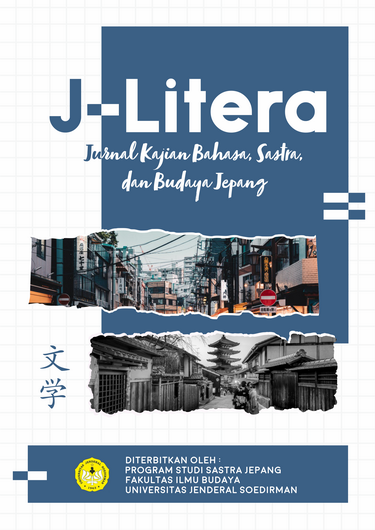COMPARISON OF AMERICAN AND RUSSIAN COLONIALIZATION IN TWO JAPANESE ANIMATION FILM ISAO TAKAHATA'S HOTARU NO HAKA AND SHIGEMICHI SUGITA'S JOPANNI NO SHIMA
Abstract
Animated films are part of literary works with a form of postmodern fiction. It is shown that animated films fulfill the requirements as literary works, which are fictitious, medium in language, and aesthetic. As a literary work, animated films have similar structures, such as characters, characterizations, settings, and plot. The purpose of this study is to compare the traces of American and Russian colonialism in both animated films by looking at their elements such as hybridity and mimicry. The research method that will be used in this research is descriptive qualitative. Descriptive research is research that aims to provide (describe) a condition or phenomenon that exists as it is. The shift in the meaning of "war" is shown from the transformation of the first film to the second film. The thing that needs to be raised is that the second film wants to restore the spirit of Japanese society. The identity of the Japanese people who easily rise from adversity is explored again. Another thing is a form of diplomacy with the Russian state. This is considering that Japan and Russia are two countries side by side. The film Jopanni no Shima wants to be a medium for the relationship between the two countries.
References
Bhaba, H. K. (1994). The Location of Culture. New York: Routledge.
Bhaba, H. K. (1998). Nation and Narration. New York: Routledge.
Boehmer, E. (2005). Colonial and Postcolonial Literature. New York: Oxford University Press.
Damono, S. D. (2009). Sastra Bandingan. Jakarta: Editum.
Faruk. (2007). Belenggu Pasca-Kolonial Hegemoni & Resistensi dalam Sastra Indonesia. Yogyakarta: Pustaka Pelajar.
Gandhi, L. (2006). Teori Poskolonial Upaya Meruntuhkan Hegemoni Barat. (Y. Wahyutri, & N. Hamidah, Trans.) Yogyakarta: Qalam.
Iles, T. (2008). The Crisis of Identity in Contemporary Japanese Film: Personal, Cultural, National. Boston: Brill.
Ireye, A. (1981). Power and Culture: The Japanese-American War 1941-1945. London: Harvard University Press.
Kono, K. (2010). Romance, Family, and Nation in Japanese Colonial Literature. New York: Palgrave.
Moore-Gilbert, B. (2000). Postcolonial Theory: Context, Practices, Politics. London: Verso.
Noor, R. (2006). Pengantar Pengkajian Sastra. Semarang: Fasindo.
Nygren, S. (2007). Japanese Cinema and The Unfolding Japanese History. Mineapolis: University of Minnesota Press.
Odell, C. (2014). Studio Ghibli: The Film of Miyazaki Hayou and Isao Takahata. Tokyo: Kamera Books.
Pratista, H. (2008). Memahami Film. Yogyakarta: Montase Film.
Ratna, N. K. (2008). Postkolonialisme Indonesia: Relevansi Sastra. Yogyakarta: Pustaka Pelajar.
Said, E. (2010). Orientalisme: Menggugat Hegemoni Barat dan Mendudukan Timur. (A. Fawaid, Trans.) Yogyakarta: Pustaka Pelajar.
Sugita, S. (Director). (2014). Jopanni ni Shima [Motion Picture]. Tokyo.
Takahata, I. (Director). (1988). Hotaru no Naka [Motion Picture]. Tokyo.
Williams, P., & Childs, P. (1997). An Introduction to Post-Colonial Theory. London: Prentice Hall.
Young, R. J. (2003). Postcolonialism. New York: Oxford University Press.

This work is licensed under a Creative Commons Attribution-ShareAlike 4.0 International License.
Authors who publish with J-Litera: Jurnal Kajian Bahasa, Sastra dan Budaya Jepang agree to the following terms:
- Authors retain copyright and grant the journal right of first publication with the work simultaneously licensed under a Creative Commons Attribution License (CC BY-SA 4.0) that allows others to share the work with an acknowledgment of the work's authorship and initial publication in this journal.
- Authors are able to enter into separate, additional contractual arrangements for the non-exclusive distribution of the journal's published version of the work (e.g., post it to an institutional repository or publish it in a book), with an acknowledgment of its initial publication in this journal.
- Authors are permitted and encouraged to post their work online (e.g., in institutional repositories or on their website) prior to and during the submission process, as it can lead to productive exchanges, as well as earlier and greater citation of published work.













.png)




